We are happy to report that Gingi and Chai were rescued! Pacific Siamese Rescue is committed to adopting out this precious pair together. 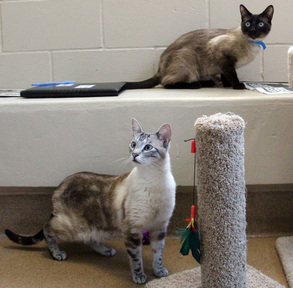 We want to stay TOGETHER! We want to stay TOGETHER! Ever since they were kittens, these two stunning Siamese have had the companionship of each other. They have slept in the same bed and shared a food dish for 3 years - life was great! Unfortunately all of this changed when their dear elderly guardian could no longer care for them and surrendered them to the shelter. Now, these 2 beautiful Siamese are in small separate cages and their hearts are broken. They don't understand what has happened. At 3 years old in cat years, this is the equivalent of 28 in human years. Can you imagine being taken away from your soul mate after 28 happy years together? Gingi (male) and Chai (female) are a bonded pair and NEED to be adopted together. Without each other, they will be heartbroken and depressed.
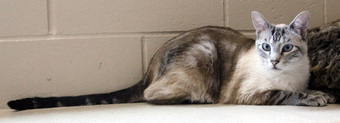 Chai - click my picture to link to my profile | 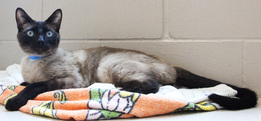 Gingi - click my picture to link to my profile | Longtime shelter volunteer Debra, says: "I have been volunteering for 7-1/2 years and I have never felt more strongly about two cats that deserve to stay together. They both are gentle, affectionate, people lovers but Gingi is more outgoing at first. I am worried that someone will take him without Chai. Gingi reassures Chai with a nose touch, then she comes out onto your lap for pets. And what a big purr motor!" Please, please don't let these cats be taken from each other. Take them both home today - they will be so grateful.
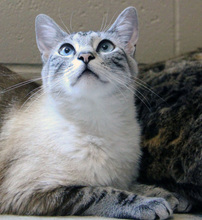 Chai the beautiful | 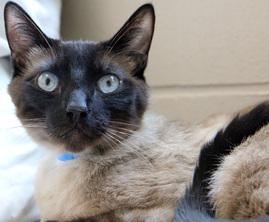 Handsome Gingi | Want to know more about this purrfect pair? Email Joan at [email protected]. Gingi and Chai are available for adoption at the San Jose Animal Care Center. Please help share their story so that they can find the perfect home together!
Recap: My name is Shirley and I was rescued from the San Jose shelter because I was too fat to be put up for adoption. Since November, I have been fostered by a caring human, and have been trying to lose weight. My weight loss has been a challenging journey. Read my previous posts here. 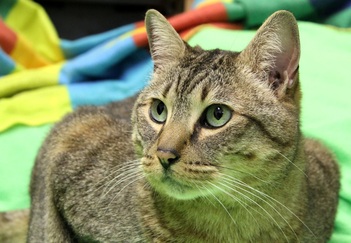 Feeling good about myself! I’m excited. It’s January and I’m scheduled to go back to Club Chub. I’m really a different girl. I am Shirley and I am a confident, happy, healthy tabby girl who is losing weight.
I spend my days grooming myself, looking out the window, climbing my cat tree and exploring the house.
There’s a new 12 year old rescue kitty here and she doesn’t keep her tail out of my face when she sits on my favorite couch. But I am being calm. I don’t hit her or hiss at her. I don’t even move. I stare at her, but she stares at our foster mom. As long as her tail stays at least 2 inches from my nose, I’m OK. I am becoming a better kitty. I know how to move if I don’t like it. I do not have to be cranky. I wish I did not share this house with so many kitties. Isn’t there a forever home for me?
I must be getting smaller. I am enjoying sitting in my foster mom’s lap. When I first got to the rescue house, I always felt like I was going to fall off her lap. Now, it seems that I fit. I have been a good girl and have been sticking to my diet. My foster mom didn’t. She said its because they closed her Weight Watchers center and the new place is too far and has bad parking. That’s her excuse. I stick to my diet. I want to be thin. I want to be adopted.
I hope my new weight is good. Then I can tell everyone in this blog. And then someone will know what a good girl I am. And maybe someone will want to be my very own diet buddy. Maybe you?
Wish me luck…
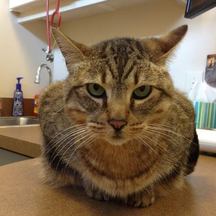 Ready for bikini season! Update: Shirley has met her target weight of 12.5 pounds! She has officially graduated from Chub Club and is ready to start her new chapter in life!Do you have a chubby pet? Just like humans, overweight animals are at great risk for health problems. Talk to your vet about a supervised weight loss program. Special thanks to Pinnacle Animal Hospital, and Shirley's foster mom for their great care of Shirley!
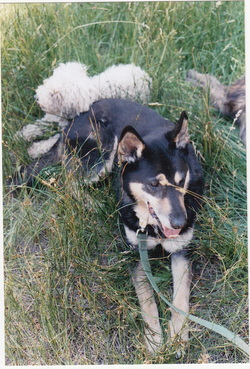 A SJAA volunteer shares her story of adopting a senior dog. An upcoming post will highlight some adoptable senior dogs who are searching for forever homes.
Marta: The Best Dog I Barely Knew
I recently read about an abandoned senior Siberian Husky waiting to be adopted at the shelter. The story reminded me of my Marta, the best dog I barely knew.
Marta had been featured in a newspaper ad. She was a beautiful eight-year-old German shepherd mix. I don’t know why I wanted her. I only knew that I did. Marta’s health was poor. A growth had been removed from the bridge of her nose and her teeth were a mess. She was short a few toes. Her blood work showed that her kidneys were in trouble. And she cried – a lot – but I knew I wanted her. All indications were that she would probably die soon. I didn’t want her to die alone in a kennel, waiting for someone to love her.
So, I brought her home. She met my two foolish dogs: a young-at-heart ten-year-old miniature poodle and an 18-month-old cattle dog. Marta slowly walked over to each and placed her head over their shoulders. Both dogs immediately sat down when she did this, and I felt as if Marta had explained that she was the queen. That same night she disappeared somewhere in the house. I finally found her behind the couch, where I had tried to coax her to sit beside me earlier. Instead, Marta made a den by dragging a blanket and a pillow to make a place where she felt safe.
Marta cried softly for weeks even though she did not seem to have any tender spots. A friend who studies Chinese Medicine suggested that she was ‘Yang deficient,’ and thus full of grief. I learned massage to try and improve her Yang, and worked on the meridians to balance her kidneys, and she began to cry less often. One day we drove near the creek where she had been found as a stray. She became excited as she sniffed the air, so I brought her back and we walked the neighborhood. She sniffed every man in a hat and blue jeans. We never found who she was looking for but something wonderful happened. Marta never cried again. She became playful. While my other dogs loved to run and tumble with each other, Marta wanted to run and chase with me.
The four of us took several camping trips that summer and became a pack. On one of our trips Marta refused to leave the car to go on the hike I had planned. While the other dogs splashed in a creek, I sat with Marta. After a while I hoped she might be willing to go on the hike when I heard the rumble of thunder and saw a crack of lightning flash over the rocky hillside near our planned route. Torrential rain quickly followed. We all bundled into the car, where we stayed dry and warm. If we had gone hiking as I had planned, we would have been miles along a rocky trail at 10,000 feet, caught in the storm.
Our happy summer reached a crescendo in early August. Marta’s blood work showed that her kidney function was improving. If she kept at the same level for another thirty days we could relax her special diet to include an occasional treat or a handful of regular kibble. And Marta finally accepted my invitation to lie on the couch. She let me rub her tummy and fell asleep in my arms, and I began to think that I’d be able to have her for a while. But that night at 4 a.m. she started to scream loudly in her sleep. Then she snored deeply and I could not wake her. An hour later she screamed again. This time I was able to wake her but she was disoriented and wobbly. The vet’s exam showed that Marta was having seizures. The vet believed her kidneys had shut down. Marta was given valium and an IV of phenobarbitol to suppress the seizures. I leaned close and told her that she could choose to go, even though I loved her and wanted her to stay. A few minutes later, Marta faded away.
Marta was with me for only five months, but she taught me so much. I am a better guardian because of her. Marta taught me that no dog-dog play time will replace the play time needed to create a strong human-dog bond. She taught me to be patient, to listen. What I interpreted as unwillingness the day we were supposed to take that hike was her way of warning me about dangerous conditions. I learned that dogs could have soft gentle mouths when they get treats. I hadn’t known it, but I had been living with sharks! Marta taught me that the couch is great, but that dogs are best served by a den of their own.
Most of all, Marta taught me that love transcends all of the things that we think are important but are really just artificial barriers, like age and health, baggage and history. Senior dogs wait in shelters everywhere, and they have a harder time finding a forever home. They wait for someone who can look beyond the grizzled muzzles and stiff joints, the bad kidneys and missing toes, the fear of high vet bills and shorter life spans, to see the love and joy they have to offer.
Adopting a dog that was older and sick did not make sense by any rational measure. But Marta was my best dog, even though I barely knew her.
If you’ve been following my postings, you know that I am Miss Shirley and I am a chubby cat. If you missed the first installment of my weight loss adventure, read it here! 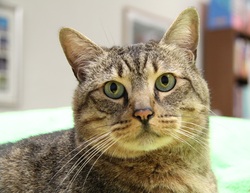 I'm trying to remain positive! When I first got to my foster home, my fur was greasy. I wasn’t really taking care of it. The Shelter cage was so small and it was hard to turn around in it—I am a big girl, you know. And I really wasn’t in the mood. I missed my family. I missed my chair.
My foster mom ignored my dirty fur for a while. I guess she was hoping I would get to it once I was out of cage. I cleaned my front paws nicely, but I couldn’t twist very well to get the rest of me. That’s because I’m fat.
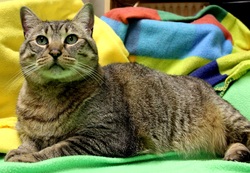 Not quite ready for bikini season So what happened? I got a bath!! So degrading! I was a good kitty, I didn’t show my claws. I did talk a lot. A lot. And it kinda felt good. And it made it easier to clean myself. I’m mean there wasn’t so much work. All I had to do was straighten everything. Still I couldn’t quite reach all of me. I’m thinking I will be able to when I become a thin kitty again.
Once I started cleaning my tummy regularly my bowels started to move more frequently. They were still kinda tough, but with less inside I was more comfortable and more mobile. Climbing the cat tree wasn’t so hard.
Well, the first week of December was a big week for me. I really wanted to show off how well I was doing on my diet. We went to Pinnacle Animal Hospital and Dr. Forgy greeted me like an old friend.
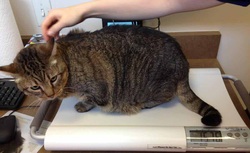 Pictures were taken to show my progress. I just knew I was doing well. Dr. Forgy said I wasn’t dehydrated so I wasn’t to worry about my bowels. As I got more active things would move better. Easy for her to say. She gave me some hope. Then I got weighed. I’d lost only 0.2 pounds. That’s just over 3 ounces! I was so disappointed. Dr. Forgy said, “That’s OK! It’s just going to take longer.” Longer! I was looking forward to going back to my old life of open feeding and lounging all day. How was I going to find a forever home if I didn’t show that I could lose weight? Was I doomed to live in a rescue house forever? Want a companion to lose weight with? Adopt Shirley!
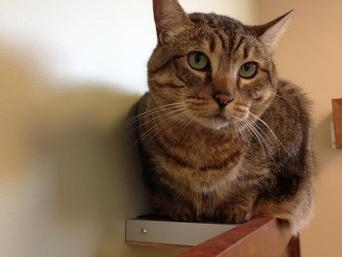 Ignore my muffin tops please Happy New Year Everyone!
I’m Miss Shirley and I am a chubby kitty. This is the story of my search for my thin kitty within. I am hoping to find my permanent home and my forever diet buddy, too.
Once upon a time, I was a normal-sized kitty. I’m not a piggy. Sometimes I leave a little food in my bowl. But I do like to lounge. I guess that was my downfall—no exercise.
When my family surrendered me to the shelter they were warned that some kitties don’t qualify for re-homing. I guess we were in denial of what could happen to me. The shelter staff told me I was too fat for their adoption program—even though I was a very friendly girl. If I didn’t find a rescue group, I would be “put to sleep.” I knew what that meant. Gulp!
So I talked to every worker and every volunteer. I greeted them with a chirp and nuzzled against the cage seductively. “Rub my head. Scratch my ears.” I have a very deep and gravelly voice and I tried to sound as sweet as I could. Some people say I sound like Lauren Bacall or Demi Moore. I say, “Who are they?”
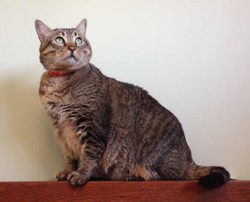 I'm just big boned My strategy worked! The St. Francis Rescue people took me to a foster home that San Jose Animal Advocates found. They arranged for my enrollment at Club Chub! Pinnacle Animal Hospital in San Jose has specialists in weight reduction and I met my doctor. Doctor Forgy was going to help me get thin so I could find a forever home! I learned that she donated her services to me because I was a rescue girl. I thought it was because of all the talking I did when we met.
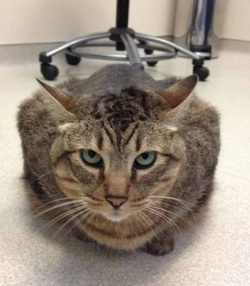 Going on a diet sucks! First, she checked my blood work. All my enzymes and electrolytes were good. Even more important—my glucose level was good. I’m not diabetic or pre-diabetic! Hooray! That improves my chances of weight loss success AND it improves the chance that I will find my forever home.
Next, she weighed me. I weighed 15.5 pounds. On my frame, that’s fat. I’m about 30% overweight and that’s morbidly obese. She took photos. No hiding the truth anymore.
Then, I was given my diet. Hill’s metabolic diet. M/D. Only ¼ cup, two times per day. The local distributor for Hill’s knew I was a rescue kitty and donated my food!
That was last November. Check back here to read more of my story.
This blog post was contributed by Tonya Jensen, SJAA Volunteer
Each year the kennels and cages of shelters are filled to capacity. Rescue groups are full with animals needing loving homes. These innocent pets must wonder, “Why Am I Here?” 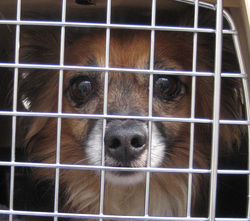 The FactsAccording to the American Society for The Prevention of Cruelty to Animals (ASPCA) estimates, “approximately 5-7 million companion animals enter animal shelters nationwide every year, and approximately 3-4 million are euthanized (60% of dogs and 70% of cats). Shelter intakes are about evenly divided between those animals relinquished by owners and those picked up by animal control.” The National Council on Pet Population (NCPPSP) reports that less than 2% of cats and 15-20% of dogs are returned to their owners (most of these were identified with tags, tattoos or microchips). (See http://www.aspca.org/about-us/faq/pet-statistics.aspx) The National Council on Pet Population and Control reports that “the majority of dogs and cats relinquished are clearly adoptable”. JOURNAL OF APPLIED ANIMAL WELFARE SCIENCE, 4(4), 237–248, Copyright © 2001, Lawrence Erlbaum Associates, Inc. ( http://www.petpopulation.org/research_euthanasia.html)
Why Then Are So Many Being Relinquished? Some of the most common reasons given for relinquishing pets are: - Moving
- Unavailable rentals
- Cost of pet maintenance
- No time for pet
- Inadequate facilities
- Neighbor complaint
- New human family member
- Limit Laws (too many pets in the home)
- Pet illness (can’t afford veterinary care)
- Personal problems
- Biting
| - Behavior (lack of training)
- Unwanted kittens and puppies
- Allergies
- House Soiling
- Escapes from containment
- Found as a stray
- Aggression towards humans
- Aggression towards other animals
- Destroys property
- Illness or death in the household (can no longer care for the animal)
- Military deployment
| 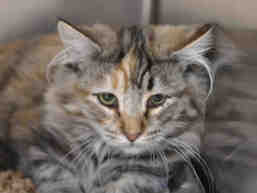 What Can Be Done?
It is not difficult to see that some of these reasons for relinquishing a pet might be eliminated by planning ahead. SEEK TRAINING. Using low cost vaccination clinics and purchasing Pet Insurance could provide relief from veterinary medical bills. Low Cost spay/neuter facilities would easy the number of unwanted kittens and puppies born each year. Assuring that your pet is identified with a collar tag, tattoo or microchip will help return your lost pet to his/her home. Provide for pets’ care in a trust or will in the event you can no longer care for them. Check limit laws and breed restrictions BEFORE bringing a pet into your home, get landlord approval if you rent. Take your pet to a day care facility or locate a dog walker if you have limited time to spend with your animal. Understand the breed or species before you choose a pet. NEVER give a pet as a gift unless you are positive the recipient is ready for and wants the responsibility of an animal. Investigate secure containment for your pet.
A pet is a thinking, feeling and needing creature. When you bring an animal into your family please be aware and ready to fill his/her needs. In return you will be repaid with unconditional love and many wonderful memories.
Editor's Note: Recently, SJAA has been facilitating the rescue of many animals who have been surrendered to our local shelter due to the family moving. Please remember that it is not the shelter's responsibility to find a new home for your pet!!! In fact, in most cases, due to the volume of animals the shelter is required to take in, you likely are risking your pet's life by surrendering it to the shelter.
This blog post has been contributed by Karen Zamel, SJAA Volunteer 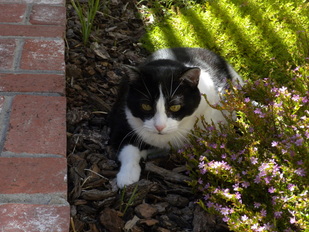 Karen's 15 year old "Mopps" As cats age, their health and wellness needs change – just like with adults. We have four cats at home, and three of them are “geriatric” – ages 13, 14 and 15. As with most pet owners, we want to keep them healthy and happy as long as possible. Our vet, Dr. Jane Johnson of Adobe Animal Hospital in Los Altos, has helped us learn about and address issues that occur for our aging family felines, and has been generous enough to share some of her important insights here.
Dr. Johnson has been part of the Adobe team since 1985 – first as a tech, and then as a vet. She has a degree in chemistry from Princeton, and a degree in Veterinary Medicine from UC Davis.
Many thanks to Dr. Johnson for these answers to our questions...
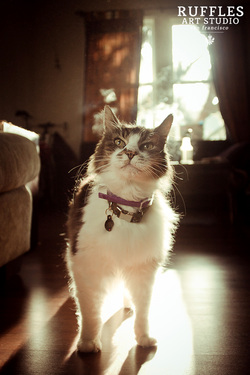 15 year old Bosco 1. At what age are cats considered "senior"?
Cats, especially indoor cats, can live over 20 years. They are considered "senior" starting at about 13 or 14 years old.
2. As pet owners, what should we watch for as our cats age?
The main things to watch for are changes – in appetite, drinking, weight, activity level, appearance, elimination habits, breathing – or the appearance of any symptoms such as coughing, sneezing, vomiting, diarrhea.
3. Are there differences in well care as our cats become older – for example, the frequency or type of vet visits?
In the older cat, we usually recommend coming in every 6 months instead of yearly, and we often will do blood tests, radiographs or other diagnostic procedures, especially if any of the above symptoms are present.
4. Dental issues are always a concern in senior cats...what kind of tooth and gum care do senior cats need?
Dental care should start at a young age, ideally with brushing the cat's teeth at least a few times weekly. In any case, the teeth and gums should be evaluated at each veterinary visit, and they should definitely be checked if you notice redness, bleeding, bad breath or masses in the mouth. Often times, the teeth need to be cleaned to eliminate plaque and the bacteria that can cause problems in the entire body. We do not recommend the anesthesia-free teeth cleaning, as these procedures do not address any decay or infection that may be occurring under the gums, and they can often lead to broken teeth and retained, infected roots.
5. What should we be alert about as our cats age? Are there changes that are okay, vs. changes we should be concerned about?
As in #2 above, most of the changes that you see in your older cat should at least be evaluated to make sure that they are part of natural aging, rather than part of a disease process. In older cats, probably the number one indication for seeing your vet would be the cat starting to drink more water – as cats age, they are prone to developing kidney disease, hyperthyroidism, or diabetes, and drinking extra water can be the first symptom of these problems.
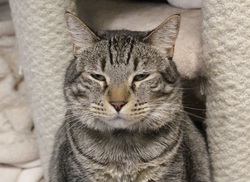 Hamilton is available at the San Jose shelter Consider Adopting a Senior…Shelters are looking urgently to find temporary or permanent homes for mature and senior cats. These loving animals are often overlooked for kittens – even when they are perfect for the adoptee. Adopting a mature or senior cat from the local shelter can be a heart- and home-warming experience. These cats can provide amazing companionship, friendship, and love. A perfect example of a wonderful senior kitty is Hamilton who is 8 years young. He has been waiting patiently at the San Jose Animal Care Center while many kittens have been adopted. This confident love muffin is waiting for you to come and adopt him. Seniors rule!
This is the second of a series of kitten-related blog posts contributed by Tonya Jensen, SVACA Kitten Foster Mom volunteer, and new SJAA volunteer.
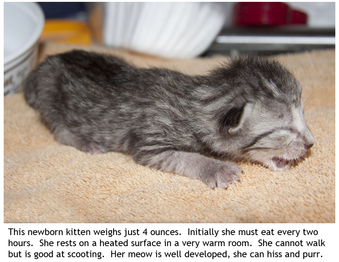 Are you sure? I’d be willing to bet that most foster parents initially exclaimed that they could never be a foster parent and gave reasons such as: - I’d fall so in love with the kittens I could not give them up.
- Maybe someday but right now I am too busy.
- I have no idea how to foster a tiny kitten.
Such reasoning filled my head until a day early in 2010 when I received a letter from Silicon Valley Animal Control Authority (SVACA) that said: “In 2009, SVACA staff had no options for 133 underage kittens, which made up 20% of the total cats and kittens who did not receive a second chance at life. Many of these kittens could have been saved if foster parents had been able to provide the necessary in-home care.”
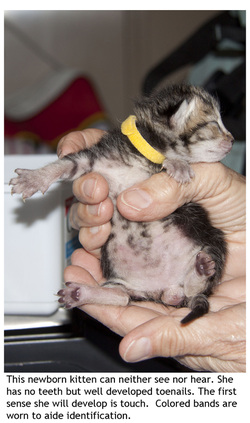 SVACA is just one small shelter in the South San Francisco Bay Area. Imagine, how many kittens euthanized in our community could have been saved if foster families had been available? SVACA alone saved 200+ kittens in 2011 because volunteers stepped up to foster kittens. Rescue groups and shelters are pleading for foster families. Could you share your home with these precious babies?
My husband and I agreed that, even though all we had almost no knowledge about cats/kittens, we had to give fostering a try. Every life is precious and deserves a chance. We filled out the paperwork, attended an orientation and within one day, had our first neo-nate litter of five little kittens. Some days are overwhelming, some moments are quite comical; at times you might be exhausted, yet many moments are pure joy. Nevertheless, because tiny neo-nate kittens are very fragile, there are a few heartbreaking times that otherwise cloud the very special foster experience. Since our first foster experience, we are now always ready to open our home to babies that need special care and are so rewarded when the final outcome is beautiful, well socialized kittens that will bring years of love, joy and memories to their forever families.
I’d Fall So in Love with the Kittens I Could Never Give Them Up!
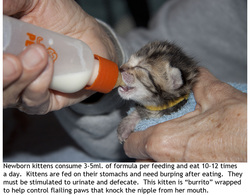
Nothing is closer to the truth than the fact that foster parents bond deeply with their tiny charges, especially those that must be bottle fed every two hours around the clock, helped to urinate and defecate, and kept warm because their tiny bodies cannot regulate heat. Foster care can include non-stop care with bottle feeding, followed by teaching the kittens to use the litter box and eat from a bowl---a rather messy period that generates a considerable amount of laundry at our house.
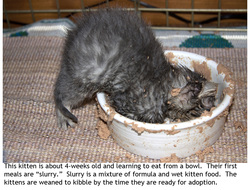 The last few weeks of foster care are the reward period as the kittens are able to take care of their own physical needs. During this time the foster family enjoys the delights of socializing and interacting with the kittens’ in play, and snuggling and cuddling with them to warm everyone’s heart. All too soon it is time to return the kittens for spay/neuter surgery and adoption. (Kittens stay in foster care until they are approximately two months old and weigh at least two pounds, the weight required for spay/neuter surgery. Law in California requires that rescue groups or shelters spay/neuter animals before adoption.) It is very hard to let the babies go and I never do say good-bye without tears and pain in my heart. I allow myself to experience the sadness because it is only personal and minor when compared to the joy the kittens will bring their families and the satisfaction of knowing that they would not be alive without a foster home to sustain them during the early weeks of their lives. Very soon there will be more kittens needing a chance and a foster home to start them on their way. These kittens will soon fill the space in my heart left behind when the previous litter left.
Maybe Someday But Right Now I am Too Busy!
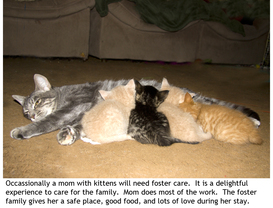 There are different needs and levels of foster care, ranging from tiny kittens weighing only a few ounces that require intense care around the clock for the first one to three/four weeks, to older kittens that are more independent once eating from a bowl and using the litter box. After about four weeks of age, kitten care is greatly minimized, generally requiring only a bowl of food, water, clean litter, clean bedding, occasional medications, and lots of socialization. Some working foster families are able to take kittens to work. Others foster older kittens that are more self-sufficient and therefore they can arrange their family schedule around the kittens’ needs. Families can opt to foster only kittens that are beyond bottles; however, the greatest need is for foster homes for the neo-nate kittens.
I Have No Experience and No Idea How To Foster Kittens!
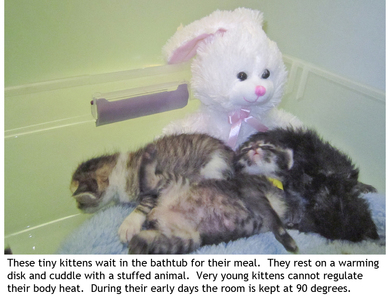 Experience isn’t a pre-requisite for becoming a foster family. Your shelter or rescue group is available to help you learn. Some supplies may come with the kittens to help you get started but it is likely that you will find yourself adding to those to fit your needs. You will need space where you can segregate the kittens from resident cats (cats carry diseases that may not be present in the adult cat but can be transmitted to the kittens and devastate to the young). If you are fostering very young kittens you will need to be able to keep them in a very warm location initially, as very young kittens cannot regulate their body temperature. In some foster homes the kittens spend their early days in the bathroom and more specifically, in the bathtub. You will need a hard-side crate for transporting the kittens. Each agency will handle medical emergencies according to their own policies but there might be times when it will be necessary for you to take a kitten to a veterinarian.
Find Foster Opportunities!
 SJAA is partnering with Humane Society Silicon Valley to recruit more kitten foster parents. Read about this local program.
If you live in other areas of the Bay Area, contact your local shelter to find foster opportunities. If they don’t have a foster program themselves, they will be able to direct you to rescue groups in the area that depend on foster families. Rescue groups may have adult cats that need a temporary home too. Adult cats may fill the bill for those that have work hours that make caring for very young kittens difficult.
UPDATE 8/12/2012: A great foster home was found today for Champ!!! He will be able to rest and recover from his surgery. San Jose Animal Advocates is facilitating finding a permanent home for Champ. If you are interested in adopting Champ, please complete this application. Any questions can be directed to [email protected].  Champ was found in school yard Like every Last Chance Pet featured on this website, time is of essence in getting them into a foster or permanent home. This is even more so in the case of Champ, a blind Pit Bull mix. On July 11, 2012, Champ was discovered half-starved and tied to the front gate at a Campbell elementary school. Champ was covered with deep puncture wounds on his body and face, and had swollen ears and eyes and bleeding abscesses on his chin. It is suspected he a ‘bait dog’—a dog used to warm-up a fighting dog before the start of a dog fight—and was subsequently left to die.
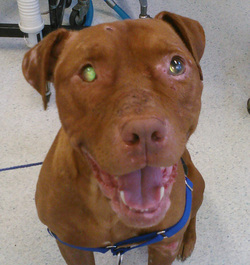 Champ is happy to be saved!
While still clinging to the last vestiges of life, Champ was immediately brought to a nearby animal hospital. The clinic cleaned up his wounds, examined his ears and abscesses and started him on vaccinations, antibiotics and pain medication. But after a full investigation of both eyes, veterinarians concluded that they were so heavily traumatized that surgery was required to remove them. Its not clear if Champ was born blind or if his blindness was caused by his injuries, but because there was so much swelling in his eyes, the vet suspected trauma was responsible. Throughout the process, Champ maintained the attitude of a ‘champ,’ (thereby earning his name), continually wagging his tail and giving the people around him lots of kisses and reasons to snuggle.
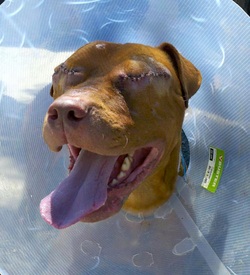 Champ has since been recovering at the veterinary hospital, but after all this, he is showing signs of kennel stress due to the barking of other animals. His handlers are concerned he might develop aggression against other dogs and leave him little time to be adopted into a permanent or foster home. San Jose Animal Advocates is committed to spreading the word about Champ's situation and helping generate funds to cover the costs of Champ’s medical expenses and find Champ a quiet, loving home where he can recover in peace and further blossom into happy dog that he already is. Stay connected with Champ's story through his Facebook page. Can you (or someone you know) provide a foster or permanent home to this animal who has been through so much, yet still maintains his loving attitude? While Champ heals, it is recommended that he be an only dog. Or would you be willing to donate funds to cover Champ’s recovery expenses? Donations can be made through Chipin.
This is the first of a series of kitten related blog posts contributed by Tonya Jensen, SVACA Kitten Foster Mom volunteer, and new SJAA volunteer.
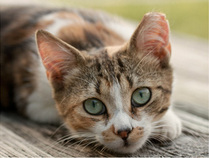
Homeless feral cats are a sad fact of our community. Numerous kittens that are not old enough or suitable for adoption are euthanized each year as a result of unmanaged feral colonies. In recent years Trap/Neuter/Return (TNR) programs established in various locations throughout the San Francisco Bay Area are becoming an important part of the solution.
What Is the Difference Between a Stray Cat and a Feral Cat? According to the ASPCA, “a feral cat is primarily wild-raised or has adapted to feral life, while we [the ASPCA] define a stray cat as someone's pet who has become lost or has been abandoned. Stray cats are usually tame and comfortable around people. They will frequently rub against legs and exhibit behaviors such as purring and meowing. In contrast, feral cats are notably quiet and keep their distance. Stray cats will also often try to make a home near humans—in car garages, front porches or backyards. Most are completely reliant on humans as a food source and are not yet able to cope with life on the streets.” What is TNR?
Trap/Neuter/Return (TNR) is a humane way of trapping of domestic cats that live in the community without formal homes and survive by gathering food and shelter where they can. The trapped cats are spayed/neutered, vaccinated, sometimes treated for other medical issues, and micro chipped. Their ears are notched so that they may be identified as spayed/neutered. They are returned to a colony in the community. What is the benefit of TNR?
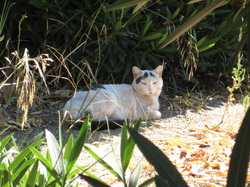 The ASPCA writes, “TNR helps the community by stabilizing the population of the feral colony and, over time, reducing it. At the same time, nuisance behaviors such as spraying, excessive noisemaking and fighting are largely eliminated, and no more kittens are born. Yet, the benefit of natural rodent control is continued. Jesse Oldham, ASPCA Senior Administrative Director of Community Outreach and the founder of Slope Street Cats, an organization dedicated to feral cat welfare, notes, “TNR also helps the community's animal welfare resources by reducing the number of kittens that would end up in their shelters—TNR creates more space for the cats and kittens who come to them from other avenues.”
According to The Cat Resource Center, a Santa-Clara based cat rescue organization, additional benefits of TNR include: “Sterilizing cats saves tax dollars, vaccination prevents disease, and TNR is the most effective and humane option for feral cats.”
Who Provides and Pays for TNR? TNR begins with various rescue groups, individuals, and in some cases, compassionate businesses. Often these dedicated people trap and provide veterinary care and food for the colonies (often paying for the procedures themselves). At times they partner with local shelters or veterinary hospitals that volunteer veterinary procedures. Available funds (from limited budgets, grants and donations) determine how many procedures a shelter can contribute to TNR. The Fate of Feral or Surrendered Kittens 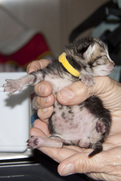 Policies vary among organizations and shelters regarding the fate of surrendered kittens. Kittens must weigh two pounds before they can be spayed/neutered, yet this procedure is required by law before kittens can be adopted from a rescue group or shelter. The availability of foster families will play a key role in the number of neo-nate kittens a shelter or organization can accept for adoption. Without foster families it is impossible for organizations and shelters to provide the care these tiny babies require, thus some precious lives may not have a chance. Before surrendering neo-nate kittens, check with organizations and shelters regarding their policies.
Feral Cat Resources:
|
 We want to stay TOGETHER!
We want to stay TOGETHER! 







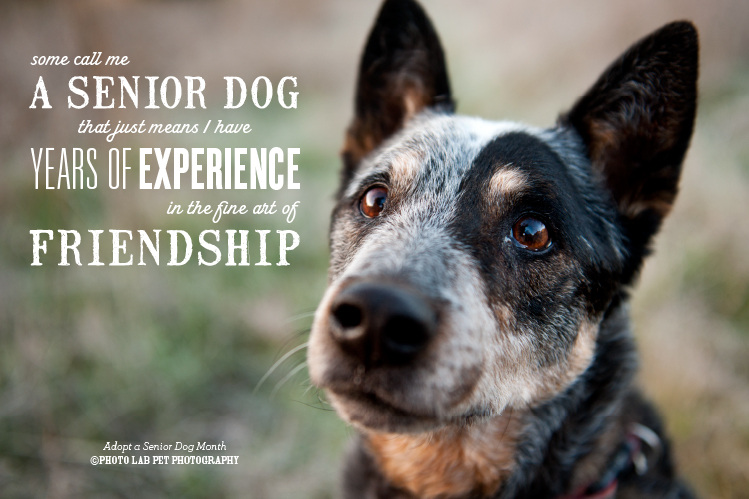






















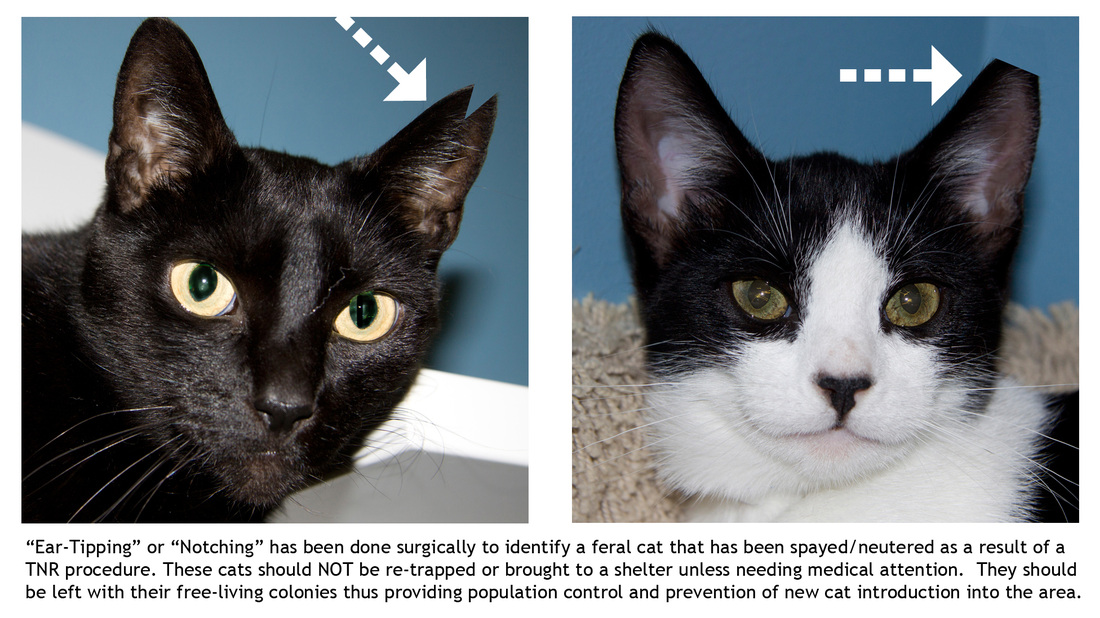


 RSS Feed
RSS Feed